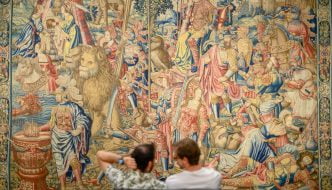Book Review: Four Sisters’ by Helen Rappaport
March 15, 2015
[Image from www.lep.co.uk]
The story of the four Romanov sisters has always been shrouded in mystery and legend. Nobody knows exactly what happened on the morning of July 17th, 1918, when their lives – as well as their parents’ – were taken away.
In Four Sisters, Helen Rappaport explains the lives of the Romanov sisters in detail, using their private letters and diaries, giving us an insight into a far different time.
It is common for everybody to think of the sisters as “a pack”, having similar personalities and tastes, and denying them any individual attributes. This is reinforced by the pictures and public images we have of them; dressed almost alike, and not having any contact with the outdoors – apart from their visits to royal families. This perception is not at all true.

[Image courtesy of The Guardian]
Olga was the oldest. Everyone agreed she had a caring and sensitive soul. She also was the brightest, as she achieved the best grades when she finished her studies and was extremely hard working, always trying to do her best. She loved to read and had a good natured heart.
Of the sisters, Olga’s love affairs suffered the most. As the oldest, it was her duty to be married first, but she had to marry someone belonging to a royal family, which reduced the list to a few candidates who didn’t suit Olga’s taste. She was more interested in the Officials of the Tsar’s Escort and fell in love – intensely and deeply – with some of them, but she knew this love had no future and tried to keep her mind busy helping to look after her ill young brother, who Olga was very close to.
Tatiana is believed the most beautiful of them all. She was closest to her mother and the one who resembled her the most. With a strong personality, dedication and sensible ideas, Tatiana was also the most reserved and coquettish, always looking forward to wearing new dresses and trying on different jewels or hairstyles.
When the war started, Olga and Tatiana joined their mother as nurses in the hospitals, where they helped the wounded soldiers who returned home.
When the family was kidnapped and all of their luxuries and privileges were taken away, Tatiana proved to be the strongest to support the whole family. Even though Olga was the oldest, everybody knew Tatiana was the one who could manage the whole situation with temperance and serenity.
Maria was known as the “most Russian” of all, not only for her looks, but also for her character and ideas.
She was really easy going, had a very big heart and a good cheerful nature. She was a talented painter and the one who was closest to her father, as most biographers believed she was Tsar Nicholas’ favourite daughter.
Everybody thought she was quite weak, because Anastasia’s strong personality took over, but when the war started and circumstances changed, she proved everybody’s assumptions wrong. Maria turned out to be the strongest to resist measles – she was the last one to suffer the illness – and was a strong support for the Tsar and Tsarina in those terrible and uncertain moments.
Anastasia is probably the most famous of the four because of the innumerable girls who claimed to be her when the war was over.
Anastasia was a force of nature; a cheeky girl who always looked on the bright side of life and had a way to put a smile on everybody’s face. She wasn’t so pleasant for her teachers though, being quite impertinent, and didn’t concentrate enough on her lessons, turning the classes into a living nightmare.
When the war began she turned out to be the family’s jester and the daughter the Tsar turned to look upon whenever he was feeling miserable.

[Image courtesy of themedicalbag.com]
The lives of these four fascinating women weren’t as ideal as we might have thought: secluded in the palace for most of their lives, they lived trapped in golden cages with barely any contact with the real world. They were very cultivated – they spoke three languages fluently – but they knew nothing about mundane things and were very naïve in simple aspects as personal relationships or how to interact in society. The relationships with people of their own age were limited to cousins and aristocracy or royal families. It is no wonder they were so fascinated – and attracted to – officials and more common people because ordinary lives seemed extraordinary to them.
After the revolution started, a drastic change happened in the lives of the four Great Duchesses; a violent and dramatic kidnapping. They experienced many emotions in the last year of their lives: fear, terror, anguish, anger, frustration, boredom, apathy and, finally, resignation and acceptance. These young women, who were once in a position of great luxury and power, accepted their situation with honour and sobriety. They didn’t complain of the lack of clothes or jewellery; only the lack of space, and separation from their parents. They never questioned their father Tsar Nicholas II for his abdication of the throne, and never let him see what was on their faces; anguish of an uncertain future.
We have to see their deaths as a terrible consequence of fanaticism. The lives of these four women were truncated, and now they can only be remembered through their diaries and letters, where we can see how their hopes and dreams were not so different from those of other young women of the time.
Visit Helen Rappaport’s website
Lucía Vázquez Bonome




Comments